Lately I’ve been having a lot of conversations around investment terms with searchers, as well as investors.
About 15 years ago, I interned at a search fund. And, over the last few years, I’ve started to invest in the asset class going direct as well as through funds of search funds.
Investing in search funds is a great way to scratch my entrepreneurial itch, extremely rewarding when a searcher finds success, and can be economically rewarding too.
This post is my attempt to share thoughts on self funded search economics in an effort to contribute to the search fund community, get feedback on my thinking from a wider audience, and of course meet more people who are doing searches/investing and may want to collaborate (please feel free to reach out!).
You can watch a video of me explaining this model here, and download the excel here:

Enterprise Value
The standard finance equation is enterprise value = debt + stock – cash. Enterprise value is how much the company itself is worth. Many times people confuse it with how much the stock is worth and find the “minus cash” part of this really confusing.
So, you can rearrange this equation to make it stock = enterprise value – debt + cash. Make more sense now?
Enterprise value is just how much you’re willing to pay for the company (future cash flows, intellectual property, etc), not the balance sheet (debt and cash).
Most investors and searchers think about the EBITDA multiple of a company on an enterprise value basis because they’ll be buying it on a cash free, debt free basis. It becomes second nature to think about EBITDA multiples and know where a given business should fall given scale, industry, etc.
However, I believe this second nature way of thinking of things can be a massive disadvantage to investors given the way EV and multiples are talked about in our community currently.
Sources of capital, the typical way to calculate enterprise value for self funded searchers
If you’ve ever looked at or put together a teaser for a self funded search deal, you will notice that the deal value is equal to the sum of the sources of capital minus deal fees and cash to the balance sheet.
As a simple example, if there is $4 mm of debt to fund the deal, $1 mm of equity, and $200k of deal fees, the enterprise value = $4 mm + $1 mm – 200k = $4.8 mm.
We’ll use slightly more complex numbers in our example: If a searcher is taking a $3.2 mm SBA loan, $850k seller note, putting in $120k themselves, getting $350k of equity from the seller, a $500k earnout, and $1.2 mm of equity financing minus $350k to the balance sheet and $250k of deal fees, then the enterprise value will be $5.62 mm.
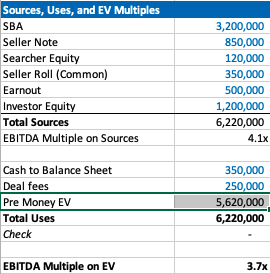
Our example company has $1.5 mm of EBITDA, so the EBITDA multiple is 3.7x. This is a pretty attractive acquisition multiple for a business that meets traditional search criteria (recurring revenues, fragmented competition, high gross margins, low customer concentration, etc).
If you’re seeing a search fund deal for the first time, the headline of “we’re buying a decent company for 3.7x, and replacing a tired owner with a hungry operator” is pretty exciting!
However, if you’re an investor, there is some nuance to this enterprise value number and the true EBITDA multiple you are investing in.
The trick with self funded enterprise value
The security that most self funded search investors get in a deal is participating preferred stock with a paid in kind dividend. This means when there’s an exit, you get your money back before any other equity holder, then get a certain percent of the business, and whatever dividend you’ve been owed in the interim accrues to your principle.
It’s a really favorable security for the investor, and one that is basically impossible to get in VC where straight preferred stock is much more common (no pun intended).
The key terms are what percent of common equity does this security convert into after the originally principal is paid back, and what is the dividend.
The share of common equity the investor group will get typically ranges from 10-50% of the total common stock. The dividend rate is usually 3-15%. The average I’m seeing now is around 30% and 10% for common and dividends respectively.
The strange this about the enterprise value quoted to investors in a teaser/CIM is that it doesn’t change as the percent of common changes, even though this has large implications for how much the common equity is worth and the value investors receive.
For example, I may get a teaser where the sources of investment – cash to balance sheet – deal fees = $3.7 mm for a $1 mm EBITDA company, which would imply a 3.7X EBITDA multiple. Let’s say the searcher is offering investors 30% of the common and a 10% dividend.
Let’s now say that the searcher is having a tough time raising capital and changes their terms to 35% of common and a 12% dividend. Does the effective enterprise value change for investors? I would argue yes, but I would be surprised to see it changed in the CIM/teaser.
This isn’t a knock on searchers or the search fund community. It’s just kind of how things are done, and I think this is mostly because it’s really hard to think about how the enterprise value has changed in this scenario.
However, the natural way of using EBITDA multiples to think about value for a business that is so common in PE/SMB can be extremely misleading for investors here. You may be thinking 3.7X for this type of business is a great deal! But, what if the security you’re buying gets 5% of the common?
If you’re in our world, you may counter this point by saying most searchers will also supply a projected IRR for investors in their CIM. However, IRR is extremely sensitive to growth rate, margin expansion, and terminal value. While the attractiveness of the security will be reflected, it can be greatly overshadowed by lofty expectations.
To get more clarity and have a slightly different mental model on the effective price investors are paying for this business, let’s go back to basics. Enterprise value should be debt + preferred stock + common stock – cash.
We know the values of each of these numbers, except the common. So, the main question here becomes: how much is the common equity worth?
Calculating value of common equity for self funded search funds
Equity value for most search fund deals = preferred equity from investors + the common equity set aside for the searcher and sometimes also advisors, board, seller.
We know that the preferred equity is investing a certain amount for a certain amount of common equity. The rub is that they are also getting a preference that they can take out before any common equity gets proceeds, and they are getting a dividend.
So, the exercise of valuing the common equity comes down to valuing the preference and dividend.
In my mind, there are three approaches:
- The discount rate method where you take the cash flows you’ll get in the future from the pref/dividends and discount them back at the discount rate of your choice. I am using 30% in my model which I believe accurately compensates investors for the risks they are taking in a small, highly leveraged investment run by an unproven operator. If you believe in efficient markets, this number also fits as it mirrors the historical equity returns as reported by the Stanford report, with a slight discount given this asset class has clearly generated excess returns relative to other assets on a risk adjusted basis, hence interest in these opportunities from an expanding universe of investors.
- The second method is to calculate how much money you’d get from your preference and dividends, taking into account that per the Stanford study around 75% of search funds will be able to pay these sums, and then discount these cash flows back at a rate more in line with public equities (7% in my model). This yields a much higher value to the preference/dividend combo, and therefore lowers the implied value of the common equity.
- The last method is to just say nope, there is no value to the preference and dividend. I need them and require them as an investor, but they are a deal breaker for me if they aren’t there, and therefore they don’t exist in my math. This of course makes no logical sense (you need them, but they also have no value?), but I’ve left it in as I think many investors probably actually think this way and it creates a nice upper bound on the enterprise value. Side note, as with obstinate sellers, jerk investors are usually best avoided.
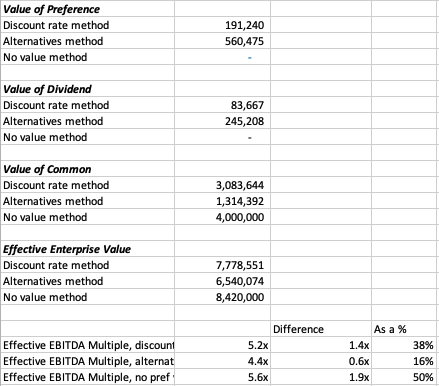
In our example, you can see a breakdown of the preference value, dividend value, and therefore common value and enterprise value for this deal.
In each case, the effective EBITDA multiple moves from 3.7x to something much higher (see the last 3 lines).
There are some simplifying assumptions in the model (no accruing dividend, all paid in last year), and some weird stuff that can happen (if you make the hold time long and the dividend greater than the 7% equity discount rate, the value of the dividend can get really big).
These flaws aside, I think this creates a nice framework to think through what the common is actually worth at close, and therefore what enterprise value investors will be paying in actuality.
It’s worth noting that the whole point of this is to benchmark the value you’re getting relative to market transactions in order to understand where you want to deploy your capital.
This creates a method to translate cash flow or EBITDA multiples of other opportunities on an apples to apples basis (if only there were a magical way to translate the risk associated with each as well!).
Another note, we could calculate the value of the common to be what this asset would trade at market today in a well run auction process minus any obligations (debt, preference, seller financing). However, I think that understates the option value inherent in this equity, a value that is only realized when a new manager takes over with more energy and know how.
There is a finance nerd rational for this. If you plot the value of equity in a leveraged company on a chart, it mirrors the payout of a call option. In both cases, the value of the security increases at a certain inflection point: when the value of equity rises above the strike price in an option, and when the enterprise value of a company rises above the debt level in a levered company.
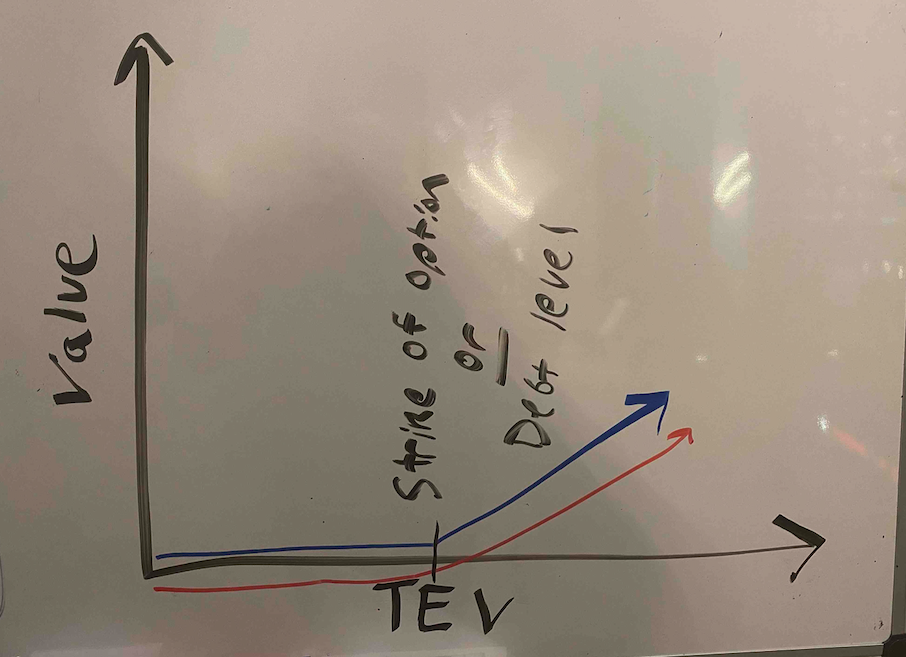
The common equity of a highly levered company can therefore be valued by a similar methodology as the call option: Black Scholes. If you remember back to finance class, increasing volatility will increase the value of an option.
In the search fund case, we’ve (hopefully) increased the (upside) volatility and therefore create more value than simply selling the company today.
A few more thoughts on investor economics
There are a few other ways to think about the economics you get as an investor to best understand if this is the deal for you.
First, you may want to think about how much your investment will be worth day 1. The key lever in this model is what discount this company is being bought for relative to fair market value. For example, the searcher may have proprietary sourced a great company and is buying it for 25% below what it would trade at in a brokered auction.
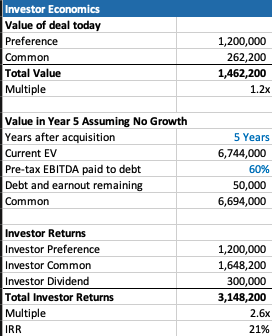
This is very much a “margin of safety” philosophy on things. Same with the calculation on how much you’ll receive in year 5 (after QSBS hits) assuming no growth in the business.
The only problem with each of these calculations is that they never play out in practice. Most companies don’t just stay the same, you’re either in a rising tide or you’re in trouble. And, you’re almost never going to sell in year 1, and definitely not for a slight premium to what it was bought for.
However, if your investment is worth 30% higher day one, and you can make a 20% IRR assuming nothing too crazy happens either way in the business, that’s not a bad place to start. Add in a strong searcher, decent market, some luck, and you’re off to the races.
Thoughts on searcher economics
A lot of this post has considered things from the investor perspective as my main quandary was related to how to create an EBITDA multiple that made sense for investors.
However, the point of this post is not to say searchers are misrepresenting or being unrealistic with their terms. In fact, I think it’s quite logical that self funded searchers capture the massive economic value that they do.
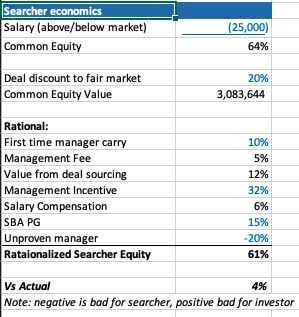
There are many reasons why self funded searchers deserve the lion share of the common equity.
First, they are providing a nice service of giving investors a positive expected value home to park their money with much lower correlation to the market than other asset classes ($1 mm EBITDA companies don’t see lots of multiple contraction/expansion throughout cycles).
Most money managers that fit that criteria are taking a 2/20, of course they also usually have a track record. So, I’ve used a 10% carry in my model, but stuck to 2% annual management fee.
The searcher spent a lot of time, and probably money, finding this company. That’s a lot of value, especially if it’s a below market price. They should be able to capture a lot of the value in finding a below market deal.
The searcher may be taking a below market salary, and needs to get comped like any CEO, with stock options. In my example model I have $1 mm of stock vesting over the hold period, as well as extra comp for taking a below market salary.
Searchers are also usually putting their financial standing at risk by taking a personal guarantee on the bank/SBA loan. This is really tough to put a number on, as is the last line in my framework where searchers are dinged for lack of experience. Like any good model, you need a few lines that you can fudge to make the math work 🙂
What you do think?
I’m shocked that I wrote all this. I was going to type a few paragraphs and a quick excel. However, putting this to paper has been a great exercise for me to sharpen my thinking.
Now I’d like you to help me further. Where do you think this should be changed in this framework? How do you think about things from the investor and/or searcher side?
Feel free to shoot me a note if you have thoughts (even just to tell me I’m being way too academic with this, which I actually agree with).
Lastly, a post like this is really a trap I’m putting on the internet to catch any like minded people in so that we can figure out ways to collaborate now or in the future. So, at the very least, connect with me on LinkedIn 🙂

Way cool! Some extremely valid points! I appreciate you penning this article and also the rest of the site is extremely good.
Please let me know if you’re looking for a writer for your weblog.
You have some really good articles and I think I would be a good asset.
If you ever want to take some of the load off, I’d love to write some articles for your blog in exchange for a link
back to mine. Please blast me an email if interested.
Many thanks!
Fantastic goods from you, man. I’ve understand your stuff previous to and you are just extremely wonderful.
I really like what you’ve acquired here, really like what you are saying and
the way in which you say it. You make it enjoyable and you still take care
of to keep it wise. I cant wait to read far more from you.
This is really a wonderful web site.
Simply desire to say your article is as amazing. The clarity to your put up is just cool and that i could think
you are a professional on this subject. Well together with
your permission allow me to grab your RSS feed to stay up to date with approaching post.
Thanks a million and please continue the gratifying work.
Its like you read my mind! You seem to understand so much approximately this, like you wrote the ebook in it or something.
I think that you can do with some percent to pressure the
message house a bit, however other than that,
this is magnificent blog. An excellent read. I will certainly be back.
Hello, its fastidious piece of writing on the topic of media print, we all be
familiar with media is a wonderful source of data.
This site truly has all the information I wanted concerning
this subject and didn’t know who to ask.
Wonderful goods from you, man. I have consider your stuff previous to and you are just extremely
wonderful. I actually like what you have got right here,
really like what you’re stating and the way by which you are saying it.
You make it enjoyable and you continue to take care of to keep it wise.
I can not wait to read much more from you. That is really a tremendous web site.
Fantastic beat ! I wish to apprentice while you amend
your web site, how can i subscribe for a blog website?
The account aided me a acceptable deal. I had been tiny bit acquainted of this your broadcast offered bright clear
concept
It’s perfect time to make some plans for the future and it is time to be happy.
I have read this post and if I could I desire to suggest you some interesting things or advice.
Perhaps you can write next articles referring to this article.
I want to read even more things about it!
We are a gaggle of volunteers and starting a new scheme in our community.
Your website offered us with helpful info to work on. You’ve performed a
formidable task and our whole neighborhood will probably
be thankful to you.
Incredible points. Great arguments. Keep up the amazing work.
Very descriptive article, I enjoyed that bit. Will there be a part 2?
I visited many web sites however the audio quality for
audio songs present at this web page is actually excellent.
I’ve been exploring for a little bit for any high-quality articles or blog posts on this kind of space .
Exploring in Yahoo I ultimately stumbled upon this web site.
Studying this info So i am happy to show that I have a very just right uncanny feeling
I came upon just what I needed. I so much definitely
will make sure to don?t put out of your mind this website and give it a look regularly.
Appreciation to my father who informed me concerning this website,
this webpage is genuinely remarkable.
My brother recommended I may like this blog.
He was once totally right. This publish actually
made my day. You cann’t believe simply how much time I had spent for this information! Thank you!
If you are going for best contents like I do, only visit
this site every day for the reason that it gives quality contents, thanks
Undeniably believe that that you said. Your favourite reason seemed to be at the net the easiest factor to be aware of.
I say to you, I definitely get irked even as folks consider
issues that they plainly do not realize about.
You managed to hit the nail upon the highest as neatly
as defined out the entire thing without having side-effects , other folks could take a signal.
Will likely be again to get more. Thank you
Everything is very open with a clear explanation of the issues.
It was really informative. Your site is very useful. Thanks for sharing!
Very nice post. I just stumbled upon your blog and wanted to
say that I’ve truly enjoyed browsing your blog posts.
After all I’ll be subscribing to your feed and I hope
you write again soon!
Attractive section of content. I just stumbled upon your website and in accession capital to assert that I
get actually enjoyed account your blog posts.
Any way I will be subscribing to your feeds and even I achievement you access consistently rapidly.
It’s actually a great and helpful piece of info. I’m glad that you shared
this helpful information with us. Please stay us up to date like this.
Thank you for sharing.
Hi friends, its impressive piece of writing concerning tutoringand
entirely explained, keep it up all the time.
Crypto’s als oplossing zien. 000 euro aan cryptomunten.
Great post. I was checking continuously this blog and I’m impressed!
Extremely helpful info particularly the remaining part
🙂 I handle such information a lot. I used to be looking for
this particular information for a very long time.
Thanks and best of luck.
I’m not that much of a internet reader to be honest but your
blogs really nice, keep it up! I’ll go ahead and bookmark your
website to come back in the future. Many thanks
I do not know whether it’s just me or if everybody else encountering problems
with your website. It looks like some of the written text on your content are running off the screen.
Can someone else please comment and let me know if this is happening
to them too? This could be a issue with my web browser because I’ve had this happen previously.
Kudos
I don’t know whether it’s just me or if everyone else experiencing problems with
your blog. It looks like some of the text within your content are running off the screen. Can somebody else please
comment and let me know if this is happening to them
too? This could be a issue with my browser because I’ve had this happen previously.
Appreciate it
Great article, just what I needed.
We stumbled over here coming from a different page and thought
I should check things out. I like what I see so now i’m following
you. Look forward to checking out your web page again.
Magnificent web site. A lot of helpful info here. I am sending it to several pals ans also sharing in delicious.
And obviously, thank you on your effort!
Its like you read my thoughts! You seem to know a lot approximately this,
such as you wrote the e book in it or something. I feel that you could do with
a few p.c. to drive the message house a little bit, but other than that, that is excellent blog.
A great read. I will definitely be back.
It’s hard to find experienced people in this particular subject,
but you seem like you know what you’re talking about! Thanks
When someone writes an article he/she retains the idea of a user in his/her mind that how a user can understand it.
Thus that’s why this piece of writing is perfect.
Thanks!
Excellent beat ! I wish to apprentice at the same time as you amend your site, how could i subscribe for a weblog site?
The account aided me a appropriate deal. I were a little bit acquainted of this your broadcast offered shiny clear concept
Oh my goodness! Incredible article dude! Many thanks, However
I am going through issues with your RSS. I don’t understand why I can’t join it.
Is there anybody else having similar RSS issues? Anyone who
knows the answer will you kindly respond? Thanks!!
I enjoy what you guys tend to be up too. This kind of clever work and coverage!
Keep up the superb works guys I’ve incorporated you guys to my blogroll.
I do consider all of the ideas you’ve introduced in your post.
They’re very convincing and will certainly work. Nonetheless, the posts are very
brief for beginners. Could you please extend them a bit from next
time? Thanks for the post.
An outstanding share! I have just forwarded this onto a co-worker who
had been conducting a little research on this.
And he actually bought me lunch simply because I discovered it
for him… lol. So allow me to reword this…. Thanks for the meal!!
But yeah, thanx for spending some time to talk about this topic here on your blog.
Right now it appears like WordPress is the preferred blogging platform
out there right now. (from what I’ve read) Is that what you are using
on your blog?
I’m amazed, I have to admit. Seldom do I encounter a blog
that’s equally educative and amusing, and let me tell you, you have
hit the nail on the head. The problem is something too few men and women are
speaking intelligently about. I am very happy
I came across this in my hunt for something relating to this.
Appreciation to my father who stated to me regarding
this web site, this website is really amazing.
Hurrah, that’s what I was looking for, what a stuff!
present here at this website, thanks admin of this web page.
What’s up i am kavin, its my first occasion to
commenting anyplace, when i read this post i thought i could also create
comment due to this good post.
I am not sure the place you’re getting your information, but
good topic. I needs to spend a while learning much more or working out more.
Thank you for great information I was looking for
this info for my mission.
Hi, i read your blog occasionally and i own a similar one and i was just wondering
if you get a lot of spam comments? If so how do you
reduce it, any plugin or anything you can advise? I get so much lately it’s driving me insane so
any assistance is very much appreciated.
It is perfect time to make some plans for the future and it’s
time to be happy. I’ve read this post and if I could I wish
to suggest you few interesting things or advice.
Maybe you can write next articles referring to this article.
I wish to read more things about it!
If you want to improve your know-how just keep visiting this site
and be updated with the latest news update posted here.
Excellent web site you’ve got here.. It’s difficult to find excellent writing like
yours these days. I really appreciate individuals like you!
Take care!!